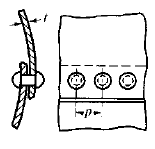Related Resources: calculators
Single-Riveted Lap-Joint Equations and Calculator
Applications and Design
Stress, Deflections and Structural Analysis
Single-Riveted Lap-Joint Formulas for Stress and Strength Design.
A riveted joint may fail by shearing through the rivets (single or double shear), crushing the rivets, tearing the plate between the rivets, crushing the plate or by a combination of two or more of the foregoing causes. Rivets placed too close to the edge of the plate may tear or shear the plate out to the edge but this type of failure is avoided by placing the center of the rivet 1.5 times the rivet diameter away from the edge.

Preview
Single-Riveted Lap-Joint Formulas for Stress and Strength Design.
The efficiency of a riveted joint is equal to the strength of the joint divided by the strength of the un riveted plate, expressed as a percentage.
Resistance to shearing one rivet:
Rs = π d2Ss / 4
Resistance to tearing plate between rivets:
Rt = ( p - D) t St
Resistance to crushing rivet or plate:
Rc = d t Sc
The safe tensile load L based on single shear of the rivets:
L = n Ar Ss
The safe tensile load L based on bearing stress:
L = n Ab Sc
The safe load L based on the tensile stress:
L = Ap St
Efficiency of Design
η = [(safe tensile load L based on single shear of the rivets) / ( l t St) ] 100
Where:
Rs = Resistance to shearing (lbs)
Rt = Resistance to tearing plate between rivets (lbs)
Rc = Resistance to crushing rivet or plate (lbs)
L = Safe Tensile Load (lbs)
η = Strength of Joint / Strength of Un-riveted plate (%)
d = diameter of holes (in)
t = thickness of plate (in)
D = Diameter of the rivet (in)
tc = thickness of cover plates (in)
p = pitch of inner row of rivets (in)
P = pitch of outer row of rivets (in)
Ss = shear stress for rivets (lbs/in2)
St = tensile stress for plates (lbs/in2)
Sc = compressive or bearing stress for rivets or plates (lbs/in2)
Related:
- Sheet Metal Gauge Size Chart
- Design of Bolted and Riveted Joints
- Rivet Application Tables and Installation
- Button Head Solid Rivet Size Table
- Acorn High Button Head Rivet
- Cone Head Rivet Size Chart
- Flat Countersunk Head Rivet
- Oval Countersunk Head Rivet
Reference Machinery Handbook, 23rd Edition